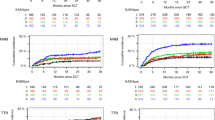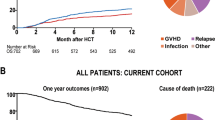Abstract
The Endothelial Activation and Stress Index (EASIX) is a prognostic tool that uses common clinical laboratory values and has been shown to predict non-relapse mortality (NRM) and overall survival (OS) at the onset of acute graft-versus-host disease (GVHD) after allogeneic hematopoietic cell transplantation (HCT). We hypothesized that EASIX calculated at different time points pre- and post- HCT may predict NRM and OS, and that EASIX calculated at onset of GVHD may predict response to steroids. We evaluated the EASIX score pre- and post-HCT in 152 patients with lymphoid malignancies undergoing unmodified reduced intensity conditioning (RIC) alloHCT with uniform GVHD prophylaxis. In multivariate analysis, EASIX calculated pre-HCT was significantly associated with higher NRM (HR = 1.64, p = 0.009) and lower OS (HR = 1.33, p = 0.046). Furthermore, EASIX calculated at day 30 and at day 100 was associated with increased NRM (HR = 1.65, p < 0.001; and HR = 1.65, p < 0.001) and decreased OS (HR = 1.27, p = 0.018; and HR = 1.49, p < 0.001), independent of HCT-CI, disease and conditioning regimen. Our study shows that high EASIX scores at various time points pre- and post-HCT are significantly associated with poorer overall outcomes. EASIX provides an independent and easily accessible tool to predict outcomes that can be complementary to other measures of risk stratification for patients undergoing HCT.
This is a preview of subscription content, access via your institution
Access options
Subscribe to this journal
Receive 12 print issues and online access
$259.00 per year
only $21.58 per issue
Buy this article
- Purchase on Springer Link
- Instant access to full article PDF
Prices may be subject to local taxes which are calculated during checkout



Similar content being viewed by others
Data availability
All data underlying the results are available as part of the article and no additional source data are required.
References
Palomo M, Fernandez-Aviles F, Ghita G, Rovira M, Fernandez-Aviles F, Martine C, et al. “Endothelial Dysfunction after Hematopoietic Stem Cell Transplantation: Role of the Conditioning Regimen and the Type of Transplantation,”. Biol Blood Marrow Transplant 2010;16:985–93.
DeLeve LD, Ito Y, Bethea NW, McCuskey MK, Wang X, McCuskey RS. “Embolization by sinusoidal lining cells obstructs the microcirculation in rat sinusoidal obstruction syndrome,”. Am J Physiol Liver Physiol 2015;284:G1045–G1052.
Postalcioglu M, Kim HT, Obut F, Yilmam OA, Yang J, Byun BC, et al. “Impact of Thrombotic Microangiopathy on Renal Outcomes and Survival after Hematopoietic Stem Cell Transplantation,”. Biol Blood Marrow Transplant 2018;24:2344–53.
Afessa B, Tefferi A, Litzow MR, Krowka MJ, Wylam ME, Peters SG. “Diffuse Alveolar Hemorrhage In Hematopoietic Stem Cell Transplant Recipients,”. Am J Respir Crit Care Med 2002;166:641–5.
Biedermann BC, Sahner S, Gregor M, Tsakiris DA, Jeanneret C, Pober JS, et al. “Endothelial injury mediated by cytotoxic T lymphocytes and loss of microvessels in chronic graft versus host disease,”. Lancet. 2002;359:2078–83.
Biedermann BC. “Vascular endothelium and graft-versus-host disease,”. Best Pract Res Clin Haematol 2008;21:129–38.
Mir E, Palomo M, Rovira M, Pereira A, Escolar G, Penack O, et al. Endothelial damage is aggravated in acute GvHD and could predict its development. Bone Marrow Transplant. 2017;52:1317–25.
Ferrara JLM, Levine JE, Reddy P, Holler E. “Graft-versus-host disease,”. Lancet. 2009;373:1550–61.
Westin JR, Saliba RM, De Lima M, Alousi A, Hosing C, Qazilbash MH, et al. “Steroid-Refractory Acute GVHD: Predictors and Outcomes,”. Adv. Hematol. 2011.
Luft T, Dietrich S, Falk C, Conzelmann M, Hess M, Benner A, et al. “Steroid-refractory GVHD: T-cell attack within a vulnerable endothelial system,”. Blood. 2011;118:1685–93.
George JN, Li X, McMinn JR, Terrell DR, Vesely SK, Selby GB, et al. “Thrombotic thrombocytopenic purpura-hemolytic uremic syndrome following allogeneic HPC transplantation: a diagnostic dilemma. Transfusion. 2004;44:294–304.
Zeisbrich M, Becker N, Benner A, Radujkovic A, Schmitt K, Beimler J, et al. “Transplant-associated thrombotic microangiopathy is an endothelial complication associated with refractoriness of acute GvHD,”. Bone Marrow Transplant 2017;52:1399–405.
Ali AM, DiPersio JF, Schroeder MA. “The Role of Biomarkers in the Diagnosis and Risk Stratification of Acute Graft-versus-Host Disease: A Systematic Review,”. Biol Blood Marrow Transplant 2016;22:1552–64.
Levine JE, Braun TM, Harris AC, Holler E, Taylor A, Miller H, et al. “A prognostic score for acute graft-versus-host disease based on biomarkers: A multicentre study,”. Lancet Haematol 2015;2:e21e–29.
Paczesny S. “Acute Graft-Versus-Host Disease Prognosis: Are Biomarkers Ready for Preemptive Clinical Trials?,”. Clin Chem. 2017;63:1561–3.
Paczesny S. “Biomarkers for posttransplantation outcomes,”. Blood. 2019;131:2193–205.
MacMillan ML, Robin M, Harris AC, DeFor TE, Martin PJ, Alousi A, et al. “A refined risk score for acute graft-versus-host disease that predicts response to initial therapy, survival, and transplant-related mortality,”. Biol Blood Marrow Transplant 2015;21:761–7.
Luft T, Benner A, Jodele S, Dandoy CE, Storb RF, Gooley TA, et al. “It Is Easix to Predict Non-Relapse Mortality (NRM) of Allogeneic Stem Cell Transplantation (alloSCT),”. Blood. 2016;128:519.
Luft T, Benner A, Jodele S, Dandoy CE, Storb R, Gooley T, et al. “EASIX in patients with acute graft-versus-host disease: a retrospective cohort analysis,”. Lancet Haematol 2017;4:e414–e423.
Ruutu T, Barosi G, Benjamin RJ, Clark RE, George JN, Gratwohl A, et al. “Diagnostic criteria for hematopoietic stem cell transplant-associated microangiopathy: results of a consensus process by an International Working Group,”. Haematologica. 2007;92:95–100.
Verma SK, Molitoris BA. “Renal Endothelial Injury and Microvascular Dysfunction in Acute Kidney Injury,”. Semin Nephrol 2015;35:96–107.
Joist JH, Baker RK. “Loss of 111Indium as indicator of platelet injury,”. Blood. 1981;58:350–3.
Coppo P, Schwarzinger M, Buffet M, Wynckel A, Clabault K, Presne C, et al. “Predictive features of severe acquired ADAMTS13 deficiency in idiopathic thrombotic microangiopathies: The French TMA reference center experience,”. PLoS One. 2010;5:e10208.
Moreau D, Timsit JF, Vesin A, Garrouste-Orgeas M, de Lassence A, Zahar JR, et al. Platelet Count Decline: An Early Prognostic Marker in Critically Ill Patients With Prolonged ICU Stays,”. Chest. 2007;131:1735–41.
Ceberio I, Devlin SM, Sauter C, Barker JN, Castro-Malaspina H, Giralt S, et al. “Sirolimus, tacrolimus and low-dose methotrexate based graft-versus-host disease prophylaxis after non-ablative or reduced intensity conditioning in related and unrelated donor allogeneic hematopoietic cell transplant,”. Leuk Lymphoma. 2015;56:663–70.
Bacigalupo A, Ballen K, Rizzo D, Giralt S, Lazarus H, Ho V, et al. “Defining the Intensity of Conditioning Regimens: Working Definitions,”. Biol Blood Marrow Transplant 2009;15:1628–33.
Hobbs GS, Kaur N, Hilden P, Ponce D, Cho C, Castro-Malaspina HR, et al. “A novel reduced intensity conditioning regimen for patients with high-risk hematological malignancies undergoing allogeneic stem cell transplantation,”. Bone Marrow Transplant 2016;51:1010–2.
Sorror ML, Logan BR, Zhu X, Rizzo JD, Cooke KR, McCarthy PL, et al. “Prospective Validation of the Predictive Power of the Hematopoietic Cell Transplantation Comorbidity Index: A Center for International Blood and Marrow Transplant Research Study,”. Biol Blood Marrow Transplant 2015;21:1479–87.
E, Casper JT, Carter SL, van Burik JA, Hurd D, Mendizabal AM, et al. “A Scheme for Defining Cause of Death and Its Application in the T Cell Depletion Trial,”. Biol Blood Marrow Transplant 2007;13:1469–76.
Rowlings PA, Przepiorka D, Klein JP, Gale RP, Passweg JR, Henslee-Downey PJ, et al. “IBMTR Severity Index for grading acute graft-versus-host disease: Retrospective comparison with Glucksberg grade,”. Br J Haematol 1997;97:855–64.
MacMillan ML, Weisdorf DJ, Wagner JE, DeFor TE, Burns LJ, Ramsay NK, et al. “Response of 443 patients to steroids as primary therapy for acute graft-versus-host disease: Comparison of grading systems,”. Biol Blood Marrow Transplant 2002;8:387–94.
Varma A, Rondon G, Srour SA, Chen J, Ledesma C, Champlin RE, et al. “Endothelial Activation and Stress Index (EASIX) Is Associated with Fluid Overload and Survival in Recipients of Allogeneic Stem Cell Transplantation,”. Biol Blood Marrow Transplant 2019;25:32–33.
Pennisi M, Sanchez-Escamilla M, Flynn JR, Shouval R, Alarcon Tomas A, Silverberg ML, et al. “Modified EASIX predicts severe cytokine release syndrome and neurotoxicity after chimeric antigen receptor T cells,”. Blood Adv 2021;5:3397–406.
Greenbaum U, Strati P, Saliba RM, Torres J, Rondon G, Nieto Y, et al. “CRP and ferritin in addition to the EASIX score predict CAR-T-related toxicity,”. Blood Adv 2021;5:2799–806.
Kanakry CG, Bakoyannis G, Perkins SM, et al. “Plasma-derived proteomic biomarkers in human leukocyte antigen-haploidentical or human leukocyte antigen-matched bone marrow transplantation using post-transplantation cyclophosphamide,”. Haematologica. 2017;102:932–40.
Kanakry CG, Bakoyannis G, Perkins SM, McCurdy SR, Vulic A, Warren EH, et al. “High day 28 ST2 levels predict for acute graft-versus-host disease and transplant-related mortality after cord blood transplantation,”. Blood. 2019;125:199–206.
Vander Lugt MT, Braun TM, Hanash S, Ritz J, Ho VT, Antin JH, et al. “ST2 as a Marker for Risk of Therapy-Resistant Graft-versus-Host Disease and Death,”. N. Engl J Med 2013;369:529–39.
Abu Zaid M, Wu J, Wu C, Logan BR, Yu J, Cutler C, et al. “Plasma biomarkers of risk for death in a multicenter phase 3 trial with uniform transplant characteristics post-allogeneic HCT,”. Blood. 2017;129:162–71.
McDonald GB, Tabellini L, Storer BE, Lawler RL, Martin PJ, Hansen JA. “Plasma biomarkers of acute GVHD and nonrelapse mortality: predictive value of measurements before GVHD onset and treatment,”. Blood. 2019;126:113–21.
Hartwell MJ, Özbek U, Holler E, Renteria AS, Major-Monfried H, Reddy P, et al. “An early-biomarker algorithm predicts lethal graft-versus-host disease and survival Find the latest version: An early-biomarker algorithm predicts lethal graft-versus-host disease and survival,”. JCI Insight. 2018;2:0–9.
Rotz SJ, Luebbering N, Dixon BP, Gavriilaki E, Brodsky RA, Dandoy CE, et al. “In vitro evidence of complement activation in transplantation-associated thrombotic microangiopathy,”. Blood Adv 2019;1:1632–4.
Rotz SJ, Dandoy CE, Davies SM. “ST2 and Endothelial Injury as a Link between GVHD and Microangiopathy,”. N. Engl J Med 2017;376:1189–90.
Luft T, Benner A, Terzer T, Jodele S, Dandoy CE, Storb R, et al. “EASIX and mortality after allogeneic stem cell transplantation,”. Bone Marrow Transplant 2019;55:553–61.
Acknowledgements
This research was supported in part by National Institutes of Health award numbers P01 CA23766 and NIH/NCI Cancer Center Support Grant P30 CA008748. The content is solely the responsibility of the authors and does not necessarily represent the official views of the National Institutes of Health. Dr. Sanchez-Escamilla was supported by Research Institute of Marques de Valdecilla (IDIVAL) Lopez-Albo-Wenceslao Grant (WLA17/03).
Author information
Authors and Affiliations
Contributions
All authors contributed substantially to the manuscript. M.S.E and M.A.P contributed to the study proposal and design. M.S.E, M.M and A.A contributed to data acquisition. P.H and D.S contributed to data analysis and interpretation. M.S.E, M.A.P and M.S drafted the Article and all authors critically revised and approved the manuscript.
Corresponding authors
Ethics declarations
Competing interests
MAP reports honoraria from Abbvie, Allovir, Astellas, Bristol-Myers Squibb, Celgene, Equilium, Exevir, Incyte, Karyopharm, Kite/Gilead, Merck, Miltenyi Biotec, MorphoSys, Novartis, Nektar Therapeutics, Omeros, OrcaBio, Takeda, and VectivBio AG, Vor Biopharma. He serves on DSMBs for Cidara Therapeutics, Medigene, Sellas Life Sciences, and Servier, and the scientific advisory board of NexImmune. He has ownership interests in NexImmune and Omeros. He has received institutional research support for clinical trials from Incyte, Kite/Gilead, Miltenyi Biotec, Nektar Therapeutics, and Novartis. MS served as a paid consultant for McKinsey & Company, Angiocrine Bioscience, Inc., and Omeros Corporation; received research funding from Angiocrine Bioscience, Inc., and Omeros Corporation; served on ad hoc advisory boards for Kite – A Gilead Company; and received honoraria from i3Health and Medscape for CME-related activity. The other authors declare no competing interests.
Additional information
Publisher’s note Springer Nature remains neutral with regard to jurisdictional claims in published maps and institutional affiliations.
Rights and permissions
Springer Nature or its licensor (e.g. a society or other partner) holds exclusive rights to this article under a publishing agreement with the author(s) or other rightsholder(s); author self-archiving of the accepted manuscript version of this article is solely governed by the terms of such publishing agreement and applicable law.
About this article
Cite this article
Sanchez-Escamilla, M., Flynn, J., Devlin, S. et al. EASIX score predicts inferior survival after allogeneic hematopoietic cell transplantation. Bone Marrow Transplant 58, 498–505 (2023). https://doi.org/10.1038/s41409-023-01922-8
Received:
Revised:
Accepted:
Published:
Issue Date:
DOI: https://doi.org/10.1038/s41409-023-01922-8
This article is cited by
-
Improving the EASIX’ predictive power for NRM in adults undergoing allogeneic hematopoietic cell transplantation
Bone Marrow Transplantation (2024)



